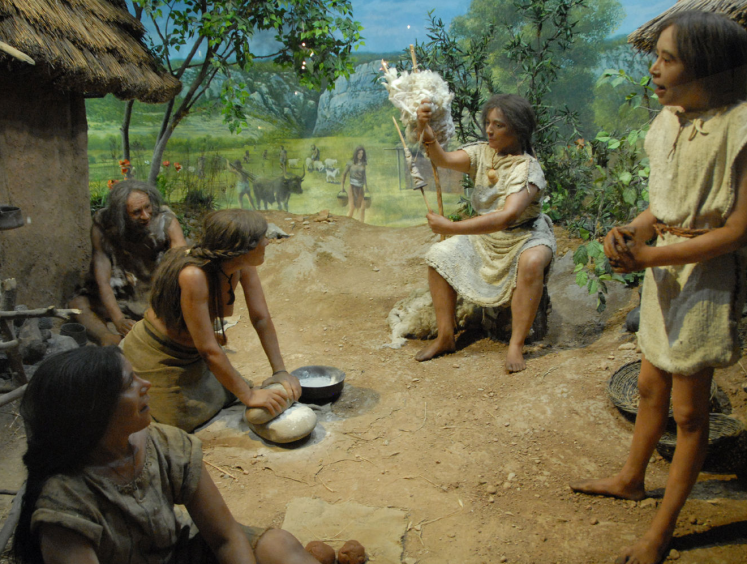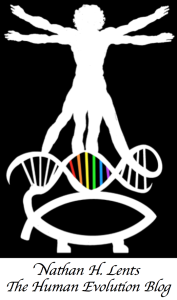[The following is highly condensed from my chapter The Decline of Violence in Spring/Nature’s new Encyclopedia of Evolutionary Psychological Science.]
Scanning the news headlines each day, we are left with the impression that our world is a cesspool of conflict and violence. The reality, however, is that our species is among the most peaceful. While Steven Pinker and others have concentrated mostly on the pacification of human society from the dawn of civilization to now, the roots of peace and harmony run much deeper. Compared to our fellow apes, human social groups are marked by elaborate cooperation, empathy, altruism, and nonviolent conflict resolution.

Scientists have long been interested in what makes human so different from other animals and, when it comes to peaceful co-existence, we have finally begun to make progress. This is important work because, by understanding how we became peaceful in the first place, we can gain insights into why and how we pursue reconciliation rather than violence and, hopefully, we can build an even more peaceful future.
There are at least six major mechanisms that have contributed to the pacification of Homo sapiens as our species evolved over the last million years or so. While some scientists quibble with one or more of these, all enjoy some measure of broad support among experts in this field.
Intelligence, Communication, and Language
I’ve often written about the impressive language of other animals, from the specific “words” of monkeys and prairie dogs to the gestures and other body language of chimpanzees. But make no mistake, human language is orders of magnitude more complex than that of any other animal. While some animals can refer to specific things, use descriptors, and make demands or requests, that seems to be as complex as it can get. Human language, on the other hand, involves many parts of speech, words with declension and multiple meanings, verbs with tense, mood, and condition, and so on.
Several lines of research have linked intelligence, language, and peaceful sociality. In primates, there is a suggestive correlation between brain size and group size, indicating that the cognitive abilities that make us unique are not all about physical skills, but social ones. Esther Herrman has crafted the “cultural intelligence hypothesis” to advance this idea. Compared to violence, peaceful conflict resolution to violence requires much more social memory, empathy, and understanding, as well as sophisticated communication and nuanced language.
Competitive cooperation
While competition and cooperation might seem to be opposites, groups of animals, including humans, often group together in order to compete against other groups. This turns an anti-social activity (competition) into a pro-social one (cooperation). Pro-sociality involves taking another’s perspective, understanding their motivations, empathizing with their emotional state, and so on. It also requires us to acknowledge that our needs must be balanced with the needs of others and to restrain our impulses to be pure “takers.”
These pro-social skills helped some groups outcompete and overpower other groups. Perhaps ironically, natural selection rewarded good cooperators and our species became more pro-social and emotionally connected, a phenomenon sometimes described as “survival of the friendliest.” These skills in cooperation, especially empathy, self-restraint, and sophisticated communication all help create social harmony and peaceful resolution of disagreements.
Cultural Group Selection
Building off of the notion that cooperative groups are more successful, groups of cooperative humans with ever-growing brains began to accumulate certain cultural features that further promoted both docility and competitive success. These features form a sort of “collective intelligence” of both skills and knowledge that grows from generation to generation. While not encoded strictly in our genes, these cultural “memes” spread in much the same way that successful genes do, a phenomenon that was probably enhanced by genetic evolution in a process called gene-culture co-evolution.
Some of the cultural features that promoted stability, harmony, and a decline of violent intra-group conflict include 1.) High capacity for social learning; 2.) Development and enforcement of social “rules;” 3.) Division of labor; 4.) Effective punishment of social deviants; 5.) Existence of “reputation” (prestige) that affects reproductive success; 6.) Self-marking of groups through symbols and other non-biological differences; and 7.) Establishment of informal “institutions” through which collective action brings group benefits. (You’ll note that some of these overlap with other mechanisms covered here. This is because cultural group selection is a theory about the mechanism of selection, rather than the precise features that were selected. It’s nevertheless an important part of the picture.)
Self-domestication
Self-domestication of humans is an idea that dates back to Darwin himself, but is picking up renewed momentum now that we are beginning to unravel the genetics of domestication. The idea is that humans have undergone the same kind of selective process that our domesticated livestock and companion animals did. Whether its cows, dogs, sheep, cats, goats, or chickens, domesticated animals are quite different than their wild ancestors. They are more docile, more tolerant, more compliant, and less aggressive, and this is because, over thousands of years, humans bred the most docile ones and eliminated the most aggressive ones.
Compared to our ancestors and our living relatives, humans show this increase in docility as well. Perhaps a similar selective process was at work as we domesticated ourselves: rewarding prosocial individuals and punishing violent ones. Strong support for this idea is found in some of the other changes that we see in domesticated animals compared to their wild ancestors: smaller teeth and mouth, smaller face, slightly smaller brains, thinner jaw, smaller eye sockets, less rigid ears, and so on. Modern humans have all of these changes as well compared to our archaic ancestors (our brains are 10% smaller than our Neanderthal cousins, for example).
We have even discovered a genetic signature of the so-called “domestication syndrome” and, you guessed it, humans have the signature.
Reduced Testosterone
While we can’t measure testosterone levels from fossils, there is evidence that average levels of circulating testosterone has steadily dropped in our species over the last 300,000 years. This evidence comes mostly from changes in our faces, as our brow ridge has become less prominent and our faces have become more rounded. Those features are known to correlate with differences in testosterone among living humans, so it is inferred that our species experienced a gradual drop in testosterone among both sexes.
Across animal species, high levels of testosterone correlate with aggression, violence, and male-dominated, conflict-based dominance regimes while lower testosterone correlates with more harmonious and egalitarian social structures. Although somewhat exaggerated in the popular imagination, the difference between aggressive and conflict-prone chimpanzees and their more peaceful female-dominated cousins, the bonobos, supports this theory as the former have markedly higher levels of testosterone than the latter.
Tolerance of strangers
A final human peculiarity that warrants mention is our tendency to be tolerant and accepting of strangers (as long as we perceive them as members of our society). Mark Moffet has recently advanced this idea in a powerful new book, The Human Swarm(which I review here). The idea is that, somewhere along the line, human societies became so large that keeping tabs on every single individual became too cognitively demanding. Instead, humans did something that is totally unthinkable for other apes: we developed trust that strangers aren’t a threat and we can peacefully co-exist with those with whom we have no relationship whatsoever (except for being recognizable as members of the same society).
*****
Putting this all together, the social and cultural milieu of the last million years of human history has been marked by increasing empathy, pro-sociality, altruism, and in-group cooperation. While violence has always been a part of our culture, it has been in steady decline as our species transitioned to so-called behavioral modernity, a transition that continues to the present. Understanding the social, cultural, genetic, and hormonal roots of this decline offers great promise for continued progress on the pacification and long-term success of our species.
[The above is highly condensed from my chapter The Decline of Violence in Spring/Nature’s new Encyclopedia of Evolutionary Psychological Science.]
-NHL


